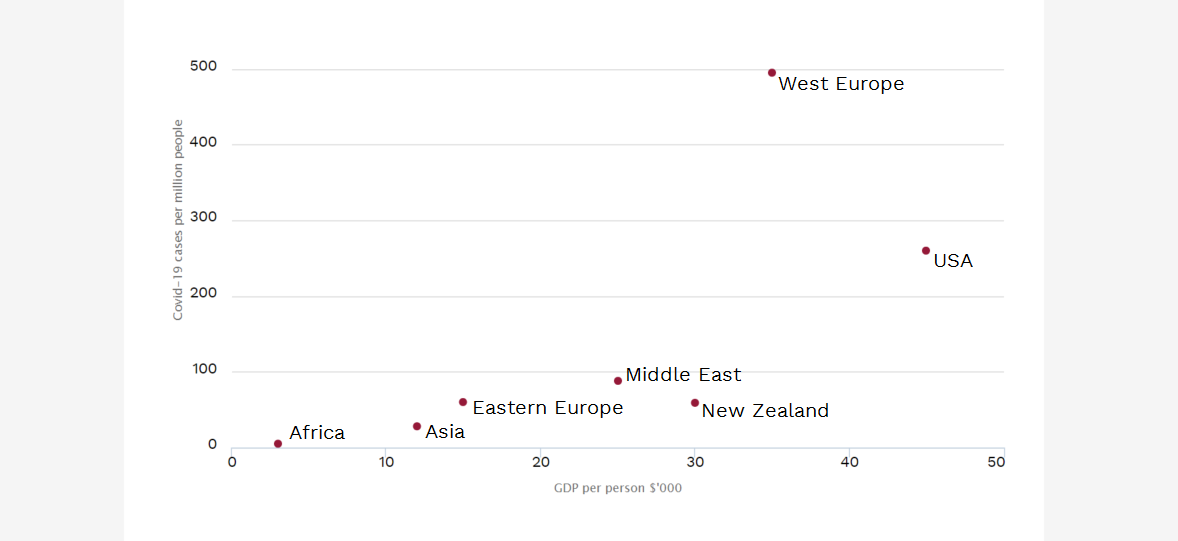The number of cases of COVID-19 virus in the world’s wealthier places like Europe and USA seem to be higher than in the poorer ones like Africa, or even Asia where the pandemic started. This is the current situation. However, the next few weeks will determine whether or not the spread to poorer countries is contained or becomes widespread.
So it could be useful for us to explore a few things:
1. The number of cases varies, but does the share of the population with COVID-19 vary?
2. Are these incidence levels related to wealth, measured as GDP per person?
3. Has New Zealand kept below COVID-19’s horizon so far?
4. What can we learn if anything from this snapshot?
This exploration uses a snapshot of COVID-19 cases recorded by last Thursday 26 March for 130 countries, and earlier World Bank GDP data. The relative place of countries doesn’t change much.
Incidence ranges from 500 to five cases per million people
The incidence of cases per million people in the main continents are very different. They range from 500 cases per million in 20 countries in Western Europe, through the Middle East’s eight countries with 88 cases per million people, Eastern Europe’s 21 countries with 60 cases per million, and Africa’s 38 countries with five cases per million people. A little surprisingly in Asia, the numbers from 19 countries average just 28 cases per million people. The highest incidence in Western Europe was in Switzerland, Italy and Spain, each with 1,200 to 1,400 cases per million people. The incidence rate in New Zealand last Thursday was 60 cases per million people
The incidence rate in New Zealand last Thursday was 60 cases per million people
Incidence currently related to average wealth in each continent
The easiest way to express the answer to that is with a chart of incidence rates against a measure of approximate average GDP per person in each continent. To be comparable between countries the GDP numbers from the World Bank are all expressed in US$000s. This is what the COVID-19 incidence graphed against average GDP per person currently looks like.

The general situation seems to be that the incidence is currently higher on the wealthier continents.
The high early number of cases in Asia seems to have been balanced with early control in a number of countries, giving them a low overall average rate.
In Africa the situation seems to be a welcome contrast to their devastation by the HIV-AIDS epidemic. Their average of just five cases per million people even though early in their infection cycle looks encouraging. However, as noted earlier, whether or not the spread through poorer countries is contained will be determined over the next few weeks.
New Zealand has relatively low COVID-19 incidence
The chart indicates that New Zealand’s average wealth is greater than that in East Europe and in the Middle East. Despite that, last Thursday our COVID-19 incidence rate was the same as that in East Europe, and below that in the Middle East. It is promising that New Zealand to date appears to have contained the spread relatively well.
It is promising that New Zealand to date appears to have contained the spread relatively well
What are some of the indications from this picture?
The fact that COVID-19 incidence is currently higher in wealthier countries may be because having higher incomes means their people travel more and spread the virus quickly as they return.
Or equally the higher income countries might attract more international travellers, those carriers of COVID-19.
Controlling the spread to, and within poorer countries may be critical over the next few weeks
In the early weeks of the outbreak international travel was the main means of spread. Since then community transmission has become dominant in many parts of the globe, especially those which were slow to react. It appears to be particularly strong in countries and cities with higher density of citizens, like northern Italy and New York. Controlling the spread to, and within poorer countries may be critical over the next few weeks.